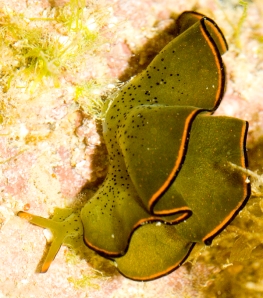While many movie-goers were saddened as they left the world of Pandora and came back to Earth, I was not. Instead, as I left the cinema after seeing James Cameron’s Avatar, I was instead happily musing about how the beautiful flora and fauna of Pandora could be created. For real. Here, on Earth.
For me, I was most amazed by the prevalence of bioluminescence among the plants, and even animals, of Pandora. The bioluminescence is especially obvious with the Trees of Souls and Tree of Voices, but nearly all plants and fungi seem to have bioluminescent properties. Bioluminescence is obvious in some Pandoran insects and lizards, and the sentient Na’vi also have lines of blue photophores on their skin.

A tank of firefly squid (Watasenia scintillans) caught off the coast of Namerikawa, Japan.
Fortunately, bioluminescence is not something entirely alien. Many organisms on our own planet are also bioluminescent, though most bioluminescent animals live in the deep ocean (though exceptions, such as glowworms and fireflies, are well-known). Bioluminescence has evolved in insects, molluscs (especially squid), fish, jellyfish, fungi, plankton and bacteria, but to my knowledge no naturally bioluminescent plant species exist on Earth.
I had to say ‘naturally’ in the last sentence of the above paragraph because in recent times, many animals and plants have been genetically engineered to express the firefly (Photinus pyralis) enzyme called luciferase. This enzyme, in the presence of its substrate (luciferin) produces a yellow-green bioluminescence. There are also many other natural and mutated enzymes, allowing for bioluminescence with colours of red , orange, yellow, green, blue and even violet.

Bioluminescence of the bitter oyster fungus (Panellus stipticus) found near Springdale, Wisconsin, USA.
With advances in the knowledge of the chemistry and biology of bioluminescence, genetically-engineered bioluminescent plants and animals may become as commonplace on Earth as on Pandora. As very efficient solar-powered lights (in addition to being very attractive), gardens might be lit by the very plants that inhabit them. We might make animals that can use bioluminescence as a signal, like pets that literally light up when they see their owner. The bioluminescent magic seen in Avatar is entirely feasible!
Na’vi are human-like in appearance, but are much taller (almost 3m tall) and have some alien characteristics – blue striped skin, pointy and mobile pinna (external part of the ear), catlike tails and (with the exception of the avatars) only four digits on their hands and feet. They also have larger (and yellow) eyes compared to human proportions, flatter noses and slimmer physiques. It’s also mentioned in the film that the Na’vi are stronger and have hardier bones. Each of these characteristics is at least biologically plausible, and so it might be possible to turn a human into something resembling very closely a Na’vi.
Some humans have traits that make them more Na’vi-like than others, and with research the genetic reasons for this difference could yield ways to make a human into a Na’vi. Pituitary gigantism (causing greatly increased growth hormone) can produce humans with heights of up to 2.7m, and it’s possible that a similar pathway can be used for genetic enhancement of skeletal height without the associated health issues of gigantism. Enhancement of bone strength might also solve some of these health problems, and I foresee that stronger bones and muscles will be a desirable trait for future human enhancement (and therefore will be well-researched). Finally, the fact that some humans naturally have very slender physiques suggest the trait might be able to be genetically engineered, and narrow waists, though historically achieved through the use of corsets, should also prove amenable to genetic modification.

An okopipi, or blue poison dart frog (Dendrobates azureus), native to Suriname and Brazil (by ucumari on flickr.com)
Inspiration for more alien features of the Na’vi was found in the animals of Earth, and perhaps we might be able to borrow from these animals genomes. As the very distant ancestors of humans had a tail, restoring one should prove relatively simple also. Animals with mobile pointed pinna exist and are well known (such as the common cat), so with some research, humans could be engineered to have similar. Reducing the number of digits might be more difficult, as five digits is the normal for most, but fortunately not all, limbed vertebrates (and, as the avatars still had five digits, reducing digits to four might not be desirable). Blue skin should be possible, though blue pigment molecules are rare, but one could perhaps be engineered and human skin engineered to produce it instead of the red and brown pigment molecules pheomelanin and eumelanin). Similarly for yellow iris pigmentation (either that, or contact lenses).
Creating the other animals of Pandora, however, might prove more difficult. The other animals seem to mostly be hexapods; Direhorses, Ikran, Thanator and Titanothere all have six legs. The base body plan for limbed vertebrates on Earth is four limbs, and there are no six-limbed vertebrates from which any inspiration can be drawn. Nonetheless, there is nothing biologically implausible about hexapodal mammals and reptiles, so one day such creatures could be created.
The Ikran (also known as Mountain Banshee) could prove the most problematic to engineer. Earth’s gravity is greater than that of Pandora, and the musculature required for powered flight is therefore much greater (and heavier). Because of this, flying creatures on Earth are seldom very large, with the largest ever to exist (Argentavis) weighing only around 100kg (certainly less than the mass of a Na’vi) and a wingspan of 6-8m (the Ikran wingspan is 14m). Though with great re-engineering of muscle tissue, strong but light muscles could circumvent this issue. But don’t even get me started on a Toruk.
So, finally I want to mention perhaps the most imaginative aspect of Pandoran biology – the entire ecosystem of Pandora is seemingly connected into one super-consciousness, termed Eywa. The roots of plants carry signals from one tree to another, and animals (including the Na’vi) have a ‘queue’ (or many queues) extending from the back of their neck, which they can use to connect to other animals (allowing sensory and motor systems to merge) or to certain plants, like the Tree of Souls and Tree of Voices, allowing memories to be accessed and other functions.

A weeping willow (Salix × sepulcralis) photographed with an infra-red filter in Washington D.C, USA (by zachstern on flickr.com)
An analogy is drawn by Dr Augustine between the network of plants on Pandora and a network of neurons in a brain. While this might be valid in terms of numbers of connections, the electrochemical signals used by neurons only travel at a maximum velocity of 120m/s. If the network of Pandora uses similar mechanisms, it would take many minutes for signals to propagate across even a small section of forest and perhaps hours to reach the entire landmass. This is far too slow to produce any coherent or conscious thought. I’m sure there’s some sort of fantastical explanation, as I’ve heard talk of psionic energy or something similarly unreal, allowing for light-speed communication. That might also explain how the animals of Pandora were connected to this network at all times without being tethered to a tree (but simultaneously makes the queue rather redundant as a form of communication).
Anyway, the biological plausibility of interfacing two animals with a queue together is much higher. The queue seems to extend from the base of the head, near the brainstem, which makes it another extension to the central nervous system, secondary to the spinal cord (it occurs to me that extending the spinal cord into the tail, and using that as a queue, might be easier to engineer). This could feasibly allow any motor signals to be sent via either the spinal cord or the queue depending on what is being controlled (e.g. the Na’vi’s hands or the Ikran’s wings), and for any sensory information to be relayed from the brain to the other organism (e.g. the Ikran’s wings to the Na’vi’s brain). A very strong Tsahaylu (connection) between two Na’vi is said to occur during mating. While I’m sure feeling what your mate does and influencing their actions would, as a reciprocal form of communication, lead to totally awesome lovemaking, I doubt that this would lead to any merging of consciousness, as this distances between the brains would be too great for coherent thoughts. Nonetheless, perhaps sharing of memories and feelings could occur, though perhaps not complete thoughts.
I don’t think it will be possible to recreate every aspect of Pandora in the near future. Floating mountains would likely be a significant geoengineering problem for many years to come. And low gravity
I think the sadness and even weltschmerz experienced by those fans of Avatar is entirely justified, but being dissatisfied with reality is nothing new to transhumanists. But I just want to say this: if you want to live in a world like Pandora, then why not go ahead and make this world (or a small section of it) just like it! If you want to be a Na’vi, then why not engineer yourself to be just like one! Go study biology: plant and animal genetic engineering, bioluminescence, biomechanics, neuroscience and so on. Are you prepared to work toward making a better planet, a better ecosystem, and better people?






 Telomerase is the enzyme that elongates the ends of chromosomes, and because these telomeres become shorter every time a cell divides, this enzyme is essential to making a cell, and an organism made of cells, become immortal. Despite this, I neglected putting telomerase on my
Telomerase is the enzyme that elongates the ends of chromosomes, and because these telomeres become shorter every time a cell divides, this enzyme is essential to making a cell, and an organism made of cells, become immortal. Despite this, I neglected putting telomerase on my
